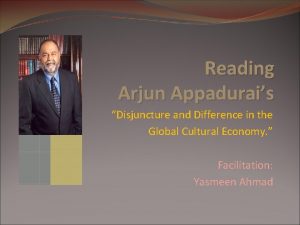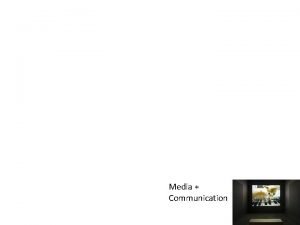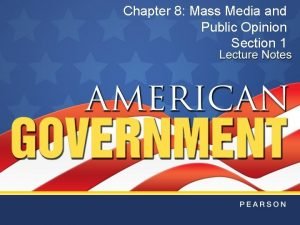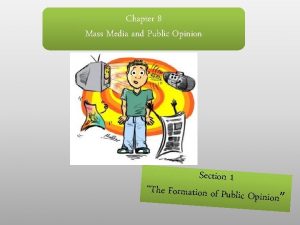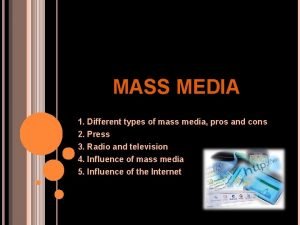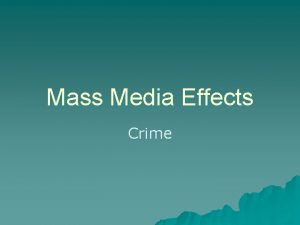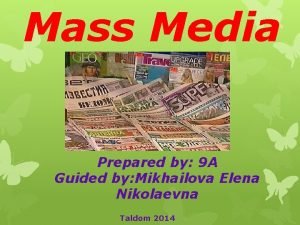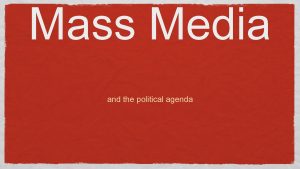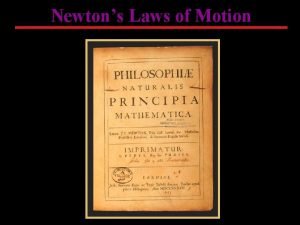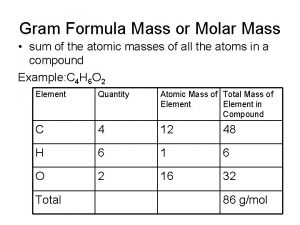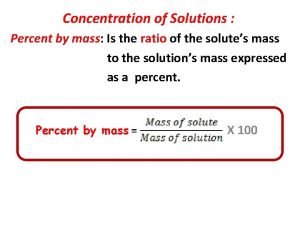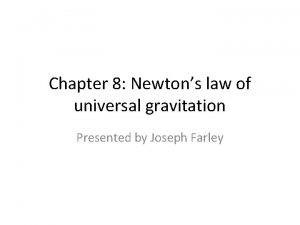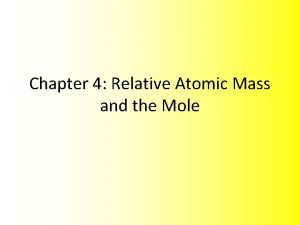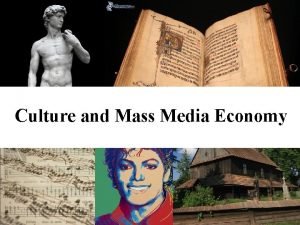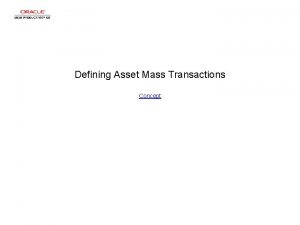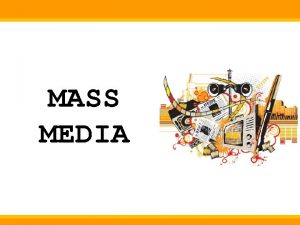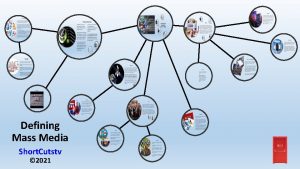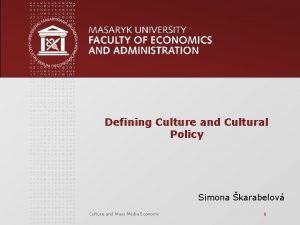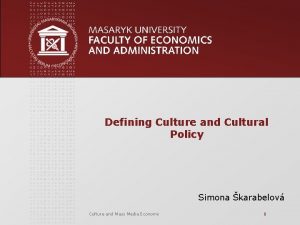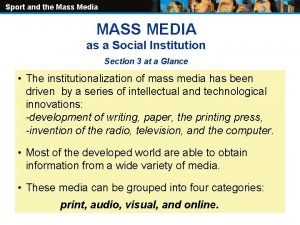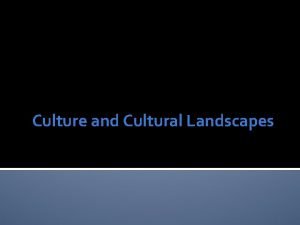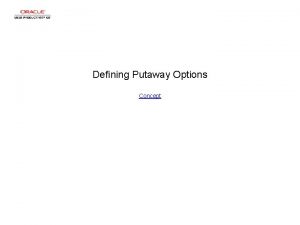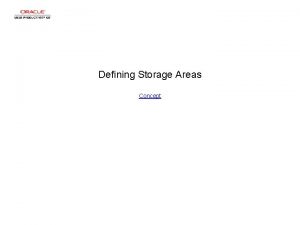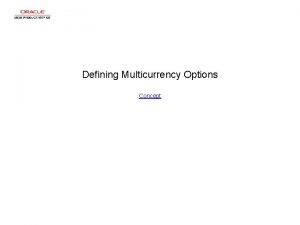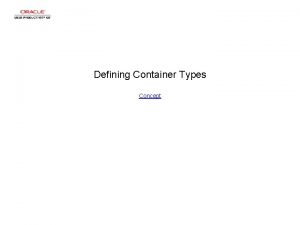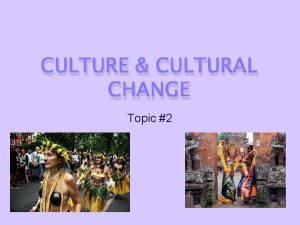Culture and Mass Media Economy DEFINING CULTURE CULTURAL











































- Slides: 43

Culture and Mass Media Economy

DEFINING CULTURE CULTURAL POLICY

Content I. III. IV. V. Definition of culture Definition of cultural economics Economic characteristics of cultural goods Cultural policy in the Czech Republic

Definitions • What is culture? • What is art? • Difference? o Group discussion

I. DEFINITION OF CULTURE

Definition of culture • Definition – long time discussions about this topic • An international debate centered in UNESCO (United Nations Educational, Scientific, and Cultural Organization) since 1960 s o Term cultural heritage

Definition of culture (cont. ) • Narrow definition – specific cultural goods and services • Wide definition – all, what make people different from other animals

Definition of culture (cont. ) • the arts and other manifestations of human intellectual achievement regarded collectively (Oxford dictionary)

High culture vs. low culture • High culture = visual and performing arts, heritage • Low culture = cultural/creative industries, mainstream

Definition of arts • the expression or application of human creative skill and imagination, typically in a visual form such as painting or sculpture, producing works to be appreciated primarily for their beauty or emotional power (Oxford dictionary)

II. DEFINITION OF CULTURAL ECONOMICS

Cultural Economics • “Economics of the arts” vs. “Cultural economics” o “Economics of the arts” more specific and narrow than the subject matter included in cultural economics o “Cultural economics” covers the creative and performing arts and heritage, as well as the cultural industries.

Cultural economics (cont. ) • Cultural economics is the application of economics to the production, distribution and consumption of all cultural goods and services.

III. CULTURAL GOODS AND SERVICES

Cultural goods and services • Name cultural goods and services you know. o Group discussion

Cultural goods and services (cont. ) • • • • Ballet Opera Orchestras Heritage Museums Publishing Cinema Television Broadcasting Music Visual arts(architecture, design, crafts, etc. ) Festivals …

Cultural goods and services • Contain creative or artistic element • Tangible (goods) vs. Intangible (services) o Examples? • Immovable vs. Movable o Examples? • Durable vs. Exist in particular time span o Examples? • Final (supplied to consumers) vs. Intermediate (involved in production of other cultural products or non-cultural output) o Examples?

Cultural goods and services (cont. ) • Have cultural goods any common elements with all other goods and services?

Cultural goods and services (cont. ) • Yes o Their production utilizes resources of land, labour and capital and other inputs, particularly human ingenuity. o These resources may have other uses, so have an opportunity cost and a price. • No o They are not all sold on the market, though many are, as are the labour services of artists and other creative workers. o Some are supplied by the government and may be provided free of charge, being financed out of taxes.

IV. CULTURAL POLICY

Cultural policy • Priorities of the state regarding culture, general idea of the government’s role in culture • Production and supply side

Cultural policy (cont. ) • Before – concerned only “high culture” • Now – broadened out, includes also cultural industries, crafts, etc.

Cultural policy (cont. ) • The EU: o Supranational (authoritative governance institutions and policymaking activities above member states) o Intergovernment prespective (bargaining processes among member states) o Confederal consociational perspective (protect own vital interests by consensus and achieve a certain unity of goals and solve common issues) • National (financing): o Central, o Regional o local government

Cultural policy (cont. ) • Ownership and cultural policy: • State-owned – owned and/or managed by civil servants (in some countries), revenues and costs absorbed by local authority (heritage) • Publicly owned organizations – mimic market forces (shops in museums) • Private organizations – controlled by financial (subsidy) and legal means (including restrictions, prescriptions)

Hillman-Chartrand model • • Facilitator – Tax reduces for donators (USA) Patron – Art Councils (UK) Architect – Ministry of culture (CZ, France) Engineer of the arts – State is owner and decisionmaker (China)

Cultural policy (cont. ) • Economic dimensions of cultural policy: • Intervention in cultural markets • Depends upon financial incentives and regulatory measures

V. CULTURAL POLICY IN THE CZECH REPUBLIC

Cultural policy in the Czech Republic • Till 1989 o State monopoly in culture o Political and ideological importance of culture o No motivation for efficient functioning of state organizations • After 1989 o Decrease in efficiency and collapsing of some cultural institutions due to inability to adapt to new economic situation o Increased prices and lack of resources on maintenance and reconstruction o Result – denationalization, privatization, transformation and dissolving of cultural organizations and spontaneous development of new infrastructure

Cultural policy in the Czech Republic (cont. ) • Cultural Policy 2009 -2014: o “the Czech Republic wants to become a cultural crossroad, it wants to utilize its natural position in a free, open and creative way in the creation of its own culture, in the preservation of cultural heritage and its application in every realm of social life. ” (Czech Ministry of culture, 2009)

Cultural policy in the Czech Republic (cont. ) • Tasks of the state: o to create optimal relations between culture and other realms of life of society, o develop creative opportunities in the economy, research and education, motivate donors, o provide sufficient resources to strengthen the competitiveness of the state in a global environment.

Cultural policy in the Czech Republic (cont. ) • Objectives: 1. Use the benefits of the arts and cultural heritage and associated creativity to increase competitive strength in other areas and activities, 2. Emphasize the role of culture in individual professional and personal development of citizens, 3. Provide direct and indirect support to maintain existing cultural values and create new values as well, 4. Create a transparent and non-discriminating environment for cultural activities

Cultural policy in the Czech Republic (cont. ) • Actual cultural policy 2015 -2020 – Document: Plan for implementation cultural policy 2015 -2020 • Support of culture identity • Support of culture diversification • Support of multicultural dialogue

Cultural policy • Cultural policy in your country?

Sources: • Presentation made by Daria Kuchařová • A handbook of cultural economics. Edited by Ruth Towse. Cheltenham: Edward Elgar, 2003. • Simona Škarabelová et al. Ekonomika kultury a masmédií. Brno: Masaryk University, 2007 • Michelle Reeves. Measuring the economic and social impact of the arts: a review. London: Arts Council of Egland, 2002 • National Cultural Policy Czech Republic 20092014. Ministry of Culture, Prague, 2009

THANK YOU FOR ATTENTION!

Short paintings Quiz Who is author of these paintings?







Results • • • Pablo Picaso Edvard Munch Vincent Van Gogh Claude Monet Josef Lada Andy Warhol
 A non-defining relative clause
A non-defining relative clause Relative clauses defining and non defining
Relative clauses defining and non defining Non defining relative clauses as sentence modifiers
Non defining relative clauses as sentence modifiers Defining relative clause meaning in telugu
Defining relative clause meaning in telugu Defining and non-defining relative clause
Defining and non-defining relative clause Non defining relative clauses
Non defining relative clauses Mass media and pop culture
Mass media and pop culture Athenian economy vs sparta economy
Athenian economy vs sparta economy Technoscape example
Technoscape example Challenges of media and information in politics
Challenges of media and information in politics Is atomic mass and relative atomic mass the same
Is atomic mass and relative atomic mass the same Differentiate between atomic number and mass number
Differentiate between atomic number and mass number Difference between atomic mass and mass number
Difference between atomic mass and mass number Atomic mass
Atomic mass Cultural model of mass communication
Cultural model of mass communication Example of mil
Example of mil Mass media questions
Mass media questions Chapter 8 mass media and public opinion worksheet answers
Chapter 8 mass media and public opinion worksheet answers Chapter 8 section 3 the mass media
Chapter 8 section 3 the mass media Chapter 19 advertising
Chapter 19 advertising Opinion image
Opinion image Mass media and crime
Mass media and crime Sport and the mass media guided reading
Sport and the mass media guided reading The mass media and the political agenda
The mass media and the political agenda Stoichiometry ratio
Stoichiometry ratio How to find mass percent composition
How to find mass percent composition Inertial mass vs gravitational mass
Inertial mass vs gravitational mass Moles liters and molarity
Moles liters and molarity Molecules to grams
Molecules to grams Molar mass def
Molar mass def Convert mass to moles
Convert mass to moles What are the units for molar mass
What are the units for molar mass Mass/mass problems
Mass/mass problems Gravitational mass vs inertial mass
Gravitational mass vs inertial mass Molar mass table
Molar mass table Molecular mass
Molecular mass Atomicity
Atomicity Mass number formula
Mass number formula How to find percent concentration
How to find percent concentration Inertial mass vs gravitational mass
Inertial mass vs gravitational mass Formula mass vs molecular mass
Formula mass vs molecular mass Atomic mass vs molar mass
Atomic mass vs molar mass Stoichiometry worksheet #2 (mole-mass mass-mole problems)
Stoichiometry worksheet #2 (mole-mass mass-mole problems) Does an iron nail gain mass or lose mass when it rusts
Does an iron nail gain mass or lose mass when it rusts








